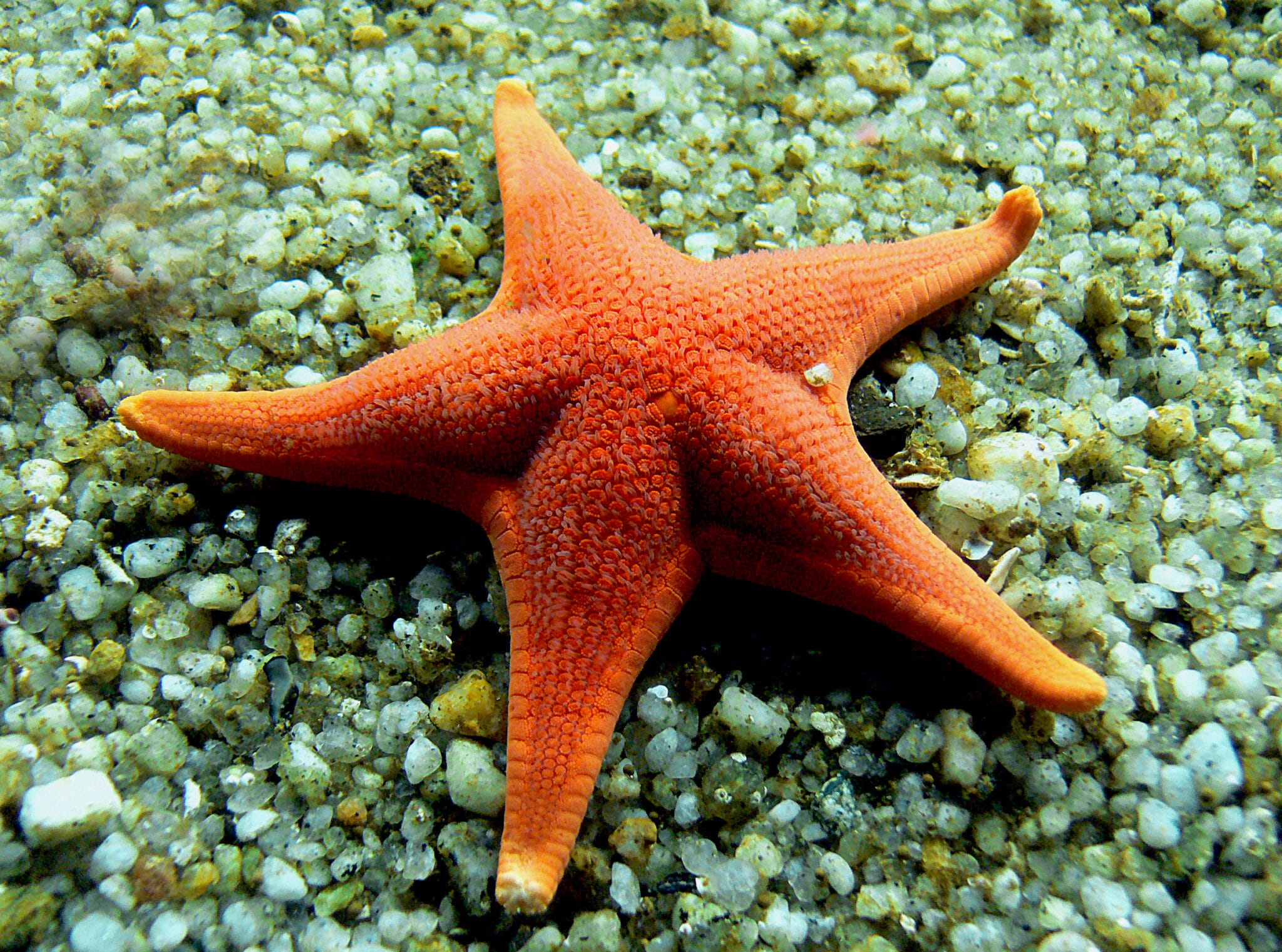Is A Starfish A Fish

Introduction
Is A Starfish A Fish: The world beneath the shimmering surface of our oceans is a realm of unparalleled mystery and wonder, teeming with an array of fascinating creatures. Among these captivating denizens of the deep, the starfish stands out as a creature that often sparks curiosity and confusion. The question that frequently arises is, “Is a starfish a fish?” The answer, however, is not as straightforward as it may seem, and delving into the intricate world of marine biology is essential to unravel this enigma.
Starfish, with their strikingly intricate radial symmetry and remarkable regenerative abilities, are indeed captivating marine organisms. Yet, despite their name, these creatures are not true fish. Rather, they belong to a completely different branch of the animal kingdom known as echinoderms. This distinction is not merely a matter of semantics but is deeply rooted in the fundamental biological characteristics that define these organisms.
In this exploration, we embark on a journey to comprehend the starfish’s true nature, exploring its anatomy, physiology, and evolutionary history. We will uncover the intriguing adaptations that have allowed starfish to thrive in diverse marine environments and even regenerate lost body parts. Along the way, we will also address the historical context that led to the misnomer “starfish” and discover how science has reshaped our understanding of these captivating creatures.
Join us as we dive into the depths of the ocean and venture into the intricate world of starfish, shedding light on their remarkable existence and elucidating the age-old question: Is a starfish a fish? Through this exploration, we hope to foster a deeper appreciation for the marvels of marine life and the importance of accurate classification in the realm of biological science.

What is a starfish classified as?
Starfish or sea stars are star-shaped echinoderms belonging to the class Asteroidea (/ˌæstəˈrɔɪdiə/). Common usage frequently finds these names being also applied to ophiuroids, which are correctly referred to as brittle stars or basket stars.
A starfish, despite its common name, is classified as an echinoderm. Echinoderms belong to the phylum Echinodermata, which is a diverse group of marine invertebrates. Echinoderms are characterized by several unique features, including radial symmetry, a water vascular system, and a calcareous endoskeleton made up of small plates. This group includes other fascinating creatures like sea urchins, sea cucumbers, and sand dollars.
Is starfish a fish or mammal?
Starfish are not fish, but they also are not mammals. Starfish are marine invertebrates that belong to the echinoderm phylum, which also includes sea urchins and sand dollars. Echinoderms are known for their tough, spiny skin. Unlike fish and mammals, they do not have backbones.
A starfish is neither a fish nor a mammal. It is essential to clarify this misconception because the common name “starfish” might suggest a connection to fish due to its aquatic habitat, but this is not accurate from a scientific perspective.
Not a Fish: Starfish are not fish. Fish belong to an entirely different branch of the animal kingdom known as Chordata. Fish are vertebrates with a backbone, while starfish are invertebrates, lacking a vertebral column. They differ significantly in terms of anatomy, physiology, and evolutionary history.
Not a Mammal: Starfish are also not mammals. Mammals are a distinct group of vertebrates belonging to the class Mammalia. They are characterized by features like having hair, giving birth to live young (with a few exceptions), and nursing their offspring with milk. Starfish do not possess these mammalian characteristics.
In summary, starfish are echinoderms, and they belong to the phylum Echinodermata. While they share their aquatic habitat with fish, they are biologically and taxonomically distinct from both fish and mammals. Understanding the proper classification of organisms is crucial for accurate scientific study and appreciation of the diversity of life on Earth.
What is a starfish if it is not a fish?
Even though they live under the sea, starfish are not actually considered fish. Starfish are echinoderms, which are marine invertebrates lacking fins, tails, and backbones. As a result, scientists prefer to refer to these creatures as sea stars. Sea stars can only be found in saltwater.
A starfish, despite its common name, is not a fish. Instead, it is classified as an echinoderm, a group of marine invertebrates that belongs to the phylum Echinodermata. Echinoderms are characterized by several unique features, such as radial symmetry, a water vascular system, and a calcareous endoskeleton. Starfish, or sea stars as they are also known, share these distinctive characteristics with other echinoderms like sea urchins, sea cucumbers, and sand dollars.
One of the most striking differences between starfish and fish is their body plan. Starfish exhibit radial symmetry, which means their bodies are organized around a central point, typically with five arms radiating outward from a central disk. In contrast, fish have bilateral symmetry, with a left and right side mirroring each other. Additionally, starfish lack many of the features typical of fish, such as a backbone, gills for respiration, and fins for swimming.
Is starfish not a fish True and false?
Starfish belongs to the invertebrate phylum Echinodermata. Silverfish belong to invertebrate phylum Arthropoda, so it is an insect. All three of these are not true fishes. They are invertebrates and do not possess any feature of true fish that we have studied earlier.
The statement “Starfish is not a fish” is undoubtedly true from a scientific and taxonomic perspective. Starfish and fish belong to entirely different branches of the animal kingdom. While the common name “starfish” may imply a connection to fish due to their habitat in the sea, this name is a misnomer. Scientifically, starfish are categorized as echinoderms, as previously explained.
However, it’s important to note that the use of the term “starfish” to describe these marine creatures is prevalent in everyday language and culture. While scientifically inaccurate, it is deeply ingrained in common vernacular. Therefore, the statement may be considered “true” in the context of accurate scientific classification but “false” in everyday informal language usage. This highlights the importance of precision in scientific terminology while recognizing the persistence of colloquial names in public discourse.
Do starfish have blood?
However, they find very clever and simple ways to get around it. Seawater is pumped throughout their body as a replacement for blood, with the water delivering key nutrients to the starfish allowing its organs to function properly.
Starfish, despite their name and appearance, do not have blood in the way that vertebrates like humans or fish do. Instead, starfish have a unique circulatory system known as a “water vascular system.” This system is a network of fluid-filled canals and chambers that circulates seawater throughout their bodies. While this system doesn’t contain red blood cells or hemoglobin like vertebrate blood, it serves a similar purpose in distributing nutrients, oxygen, and waste products to and from different parts of the starfish’s body.
The water vascular system also plays a crucial role in the starfish’s movement. It powers their tube feet, which they use for locomotion, feeding, and other essential activities. By adjusting the pressure of the fluid in their tube feet, starfish can create suction, allowing them to cling to rocks or move across the ocean floor.
Why is a fish called starfish?
Starfish aren’t fish – finned, tailed animals with backbones – they are echinoderms, which are marine invertebrates. So scientists prefer to call these animals sea stars. Sea stars come in all sizes, shapes and colors. Their most noticeable characteristic is their arms, which form their distinctive star shape.
The term “starfish” is somewhat of a misnomer because starfish are not fish at all. The name “starfish” likely originated from their distinctive appearance, characterized by multiple arms radiating from a central body, which resembles a star. Historically, people may have given them this name based on their visual resemblance to celestial stars. However, this naming convention can be misleading from a scientific standpoint.
To avoid confusion and promote more accurate classification, many scientists and organizations now prefer to use the term “sea star” instead of “starfish” when referring to these marine animals. This shift in terminology reflects a more precise understanding of their biological classification. While the name “starfish” is still commonly used in everyday language, it’s important to recognize that it is not scientifically accurate and can lead to misunderstandings about these fascinating creatures’ true nature as echinoderms, not fish.
Can a starfish bite?
Most starfish are not poisonous, and since they can’t bite or sting us, they pose no threat to humans. However, there’s a species called the crown-of-thorns starfish which is venomous, and if their spines pierce the skin they can be venomous.
No, starfish cannot bite in the traditional sense that animals with jaws or teeth can. Starfish are marine invertebrates with a unique feeding mechanism. They do not possess the physical structures necessary for biting or chewing like mammals or other animals. Instead, starfish are primarily carnivorous and feed by a process known as “extruding their stomach.”
When a starfish encounters prey, typically bivalves like clams or mussels, they use their tube feet to hold onto the shell of the prey. Then, they extend their stomach out through their mouth and into the gap between the two halves of the shell. Digestive enzymes are released from the stomach onto the prey, which gradually breaks down the tissues inside the shell. This liquefied prey is then absorbed into the starfish’s stomach, providing it with nutrients.
So, while starfish do interact with their prey in a way that allows them to feed, it doesn’t involve biting or chewing in the way that animals with teeth do. Instead, their feeding mechanism is a fascinating adaptation to their marine environment.
Do starfish give birth?
Reproduction: Sea stars are broadcast spawners. Males release sperm into the water and females release eggs. The fertilized eggs hatch into a larval form that lives as plankton, sometimes for months, before settling on the sea floor in its adult form.
Starfish do not give birth to live offspring in the same way that mammals do. They have a distinct method of reproduction. Starfish are known for their unique reproductive strategy, which typically involves external fertilization and a complex life cycle.
When it’s time to reproduce, male and female starfish release their eggs and sperm into the water. Fertilization occurs externally when the sperm meets the eggs in the open ocean. Once fertilized, the eggs develop into larvae. These larvae go through several stages of development while floating in the water column. During this phase, they are vulnerable to predation and environmental conditions.
After a period of development as larvae, they eventually settle on the ocean floor. There, they undergo metamorphosis and transform into juvenile starfish. This complex life cycle, involving both sexual and asexual reproduction methods depending on the species, is characteristic of many echinoderms, including starfish. It is essential for their survival and adaptation to various marine environments.

Conclusion
In the depths of our exploration into the world of starfish, we have uncovered a captivating tale of nature’s complexity and evolution. Our journey has clarified the age-old question: a starfish is not a fish, but rather an echinoderm. This revelation emphasizes the importance of precise scientific classification and highlights the inherent intricacies of our natural world.
As we conclude our exploration, we must reflect on the enduring wonder that starfish bring to our understanding of marine life. Their unique features, such as radial symmetry and regenerative abilities, remind us of the boundless diversity of life that inhabits our oceans. It serves as a poignant reminder that nature often defies simplistic categorization and invites us to look beyond names and labels to appreciate the beauty of each organism in its own right.
Furthermore, our journey has exposed the historical origins of the term “starfish” and its role in shaping our perceptions of these remarkable creatures. While it may be a misnomer, it has undoubtedly left an indelible mark on our collective understanding of these marine marvels.
In closing, our exploration of the starfish has been a testament to the wonders of scientific inquiry. It has demonstrated that beneath the surface of even the most familiar concepts lie layers of complexity waiting to be unraveled. By delving into the world of starfish, we not only learn about these intriguing echinoderms but also gain a deeper appreciation for the intricacies of life on our planet.
As we continue to explore the natural world, let us carry with us the lessons learned from our journey into the enigmatic realm of the starfish—a reminder that the pursuit of knowledge is a journey filled with unexpected discoveries, and that every creature, whether a fish or not, has a unique role to play in the tapestry of life on Earth.



